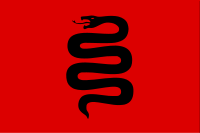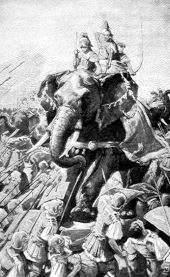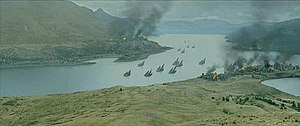Harad
| Harad | |
|---|---|
| J. R. R. Tolkien's legendarium location | |
 Haradrim chieftain's standard | |
| First appearance | The Fellowship of the Ring |
| In-universe information | |
| Other name(s) | Haradwaith, Hyarmen, the Sunlands |
| Type | Vast hot southern region |
| Locations | Umbar, Near Harad, Far Harad |
In
Tolkien based the Haradrim on ancient
In
Middle-earth narrative

Geography

Harad is a large land in the south of
The
The great harbour city of Umbar lies on Harad's north-west coast; its natural harbour is the base of the Corsairs of Umbar, inspired by the
Elsewhere in Harad there are "many towns";[T 6] one of these is "the inland city", the home of Queen Berúthiel (mentioned by Tolkien in an interview).[5] The Harad Road is the main overland route between Gondor and Harad.[T 7] Harad possesses jungles with apes,[T 8] grasslands,[T 9] and deserts.
Gondor described Harad as consisting of Near Harad and Far Harad. Near Harad corresponds loosely with North Africa or the Maghreb, while Far Harad, the vastly larger of the two regions, corresponds loosely with sub-Saharan Africa. Tolkien's own annotated map of Middle-earth, used by the illustrator Pauline Baynes to construct her iconic map, suggests that "Elephants appear in the great battle outside Minas Tirith (as they did in Italy under Pyrrhus) but they would be in place in the blank squares of Harad – also camels."[6]
People
The
History
The Haradrim are independent peoples, but in the
Tolkien did not work out any particular languages for the Haradrim, though mûmak, "elephant", may be in the Harad language.[8] Despite having a meaning in Quenya ("fate"), the name Umbar is adapted from the natives' language and not from Elvish or Adûnaic.[9]
Concept and creation
"Sigelwara Land"
Tolkien arrived at the idea of Harad, a hot Southern land, through his
| Codex Junius 11 (Old English) |
Modern English[11] |
|---|---|
| .. be suðan Sigelwara land, forbærned burhhleoðu, brune leode, hatum heofoncolum. | "... southward lay the Ethiop's land, parched hill-slopes and a race burned brown by the heat of the sun." |

Tolkien was interested in particular in the Old English word used for "
Tolkien decided that Hearwa was related to the Old English heorð, meaning "
In drafts of The Lord of the Rings, Tolkien toyed with names such as Harwan and Sunharrowland for Harad, which were derived from Sigelwara; Christopher Tolkien notes that these are connected to his father's Sigelwara Land.[T 10] The philologist Elizabeth Solopova similarly notes that the hobbits' name for Harad, Sunland, suggests a similar link.[17]
Moral geography

The
Solopova argues that the Haradrim's mûmakil war elephants put their country far to the East, since only India and lands to its east went on using war elephants after classical times.
The stereotypical "Other"

Commentators such as Anderson Rearick and Stephen Shapiro have identified the Haradrim as a recognisably foreign race as well as the enemy, and have accused Tolkien of racism.
In other media
In
The Haradrim and the Corsairs of Umbar appear in much merchandise for the film trilogy, such as toys, The Lord of the Rings Trading Card Game, and the computer game The Lord of the Rings: The Battle for Middle-earth II.[31][32][33] "Haradrim Slayers" feature in the computer game The Lord of the Rings: War of the Ring,[34] while in the video game Middle-earth: Shadow of War, Baranor, a playable character who is a captain in Gondor's guard, is originally from Harad.[35]

See also
- Chronicles of Narnia[44]
Notes
References
Primary
- Akallabêth"
- ISBN 0 04 823046 4"I've heard tales of the big folk down away in the Sunlands. Swertings we call 'em in our tales; and they ride on oliphaunts, 'tis said, when they fight."
- ^ Tolkien 1954a "The Council of Elrond"
- ISBN 0-04-823179-7
- ^ a b Tolkien 1955, "The Battle of the Pelennor Fields" "for black against the glittering stream they beheld a fleet borne up on the wind: dromunds, and ships of great draught [with deep hulls] with many oars, and with black sails bellying in the breeze."
- ISBN 0 04 823139 8
- ^ Tolkien 1955, book 6 ch. 2
- ^ Tolkien 1954 book 3 ch. 7 "apes in the dark forests of the South"
- ^ Tolkien 1955, Appendix A:II "the far fields of the South"
- ^ a b Tolkien 1989, ch. XXV p. 435 & p. 439 note 4
- ^ a b c d Tolkien 1955, book 4 ch 4, "Of Herbs and Stewed Rabbit"
- ^ Tolkien 1954, Appendix A §I(iv)
- ^ Tolkien 1955, book 5 ch 6, "Battle of the Pelennor Fields"
- Of the Rings of Power and the Third Age"
- ^ Tolkien 1955, Appendix A §I(iv) footnote
- ^ Tolkien 1955, Appendix A §I(iv)
- ^ Tolkien 1955, book 5 ch. 6 and book 6 ch. 4
- ^ Tolkien 1955, book 6 ch. 5
- ^ a b J. R. R. Tolkien, "Sigelwara Land" Medium Aevum Vol. 1, No. 3. December 1932 and Medium Aevum Vol. 3, No. 2. June 1934.
- ^ Tolkien 1954, book 4, ch. 3 "The Black Gate is Closed"
Secondary
- ^ ISBN 978-0-19-258029-0.
- ISBN 978-0-330-41165-3.
- ^ a b Morwinsky, Thomas (January 2008). "Númenórean Maritime Technology". Other Minds Magazine (2): 28–29.
- ^ Cole, Michael (March 2015). "Pirates of Middle Earth" (PDF). RPG Review (26–27): 56–73.
- ^ "The Realms of Tolkien". originally published in New Worlds in November 1966, reprinted in Carandaith in 1969 and again in Fantastic Metropolis in 2001. Retrieved 1 February 2020.
- ^ a b c Kennedy, Maev (3 May 2016). "Tolkien annotated map of Middle-earth acquired by Bodleian library". The Guardian.
- ^ ISBN 1-135-88034-4.
- ISBN 978-0-330-41165-3.
- S2CID 143443789.
...in primitive Quenya umbar, 'fate,' ...
- ^ Shippey 2005, p. 54.
- ^ "Junius 11 "Exodus" ll. 68-88". The Medieval & Classical Literature Library. Retrieved 1 February 2020.
- ^ J. R. R. Tolkien, "Sigelwara Land" Medium Aevum Vol. 1, No. 3. December 1932 and Medium Aevum Vol. 3, No. 2. June 1934.
- ^ a b Shippey 2005, pp. 48–49.
- ^ Shippey 2005, p. 48.
- ^ Shippey 2005, p. 49.
- ^ a b Shippey 2005, pp. 54, 63.
- ^ ISBN 978-1-137-45470-6.
- ^ ISBN 1-135-88034-4.
- ISBN 1-135-88034-4.
- ISBN 978-0875483030.
- OCLC 1041902253.
- ISBN 978-1403946713. translating the Homily on the Maccabees. II, 499-519.
- S2CID 162647975.
- ^ a b Shapiro, Stephen (14 December 2002). "Lord of the Rings labelled racist". The Scotsman.
- ^ Straubhaar 2004, p. 112.
- ^ a b c Straubhaar 2004, p. 113.
- ^ a b Straubhaar 2004, p. 114.
- ^ Straubhaar 2004, p. 115.
- ^ a b Ibata, David (12 January 2003). "'Lord' of racism? Critics view trilogy as discriminatory". Chicago Tribune.
The Haradrim are more recognizable. They are garbed in turbans and flowing crimson robes. They ride giant elephants. They resemble nothing other than North African or Middle Eastern tribesmen. A recently released "Towers" companion book, "The Lord of the Rings: Creatures," calls the Haradrim "exotic outlanders" whose costumes "were inspired by the twelfth-century Saracen warriors of the Middle East."
- ^ "3 Most Photographed Lord of the Rings Locations". Pure Glenorchy Scenic Film Location & Lord of the Rings Tours. 18 December 2019. Archived from the original on 28 September 2020. Retrieved 14 January 2021.
- ^ Radcliffe, Doug. "The Lord of the Rings, The Battle for Middle-earth II Game Guide. Walkthrough: Evil Campaign". Gamespot. CBS Interactive.
- ^ Kerkhove, Devon (21 September 2005). "The Lord of the Rings: Online Trading Card Game – Starter Deck Guide". GameFAQs.
- ^ Rorie, Matthew (17 July 2006). "The Lord of the Rings, The Battle for Middle-earth II Walkthrough". Gamespot.
- ^ "The Lord of the Rings: War of the Ring - Perfect Walkthrough". IGN. 2010. Retrieved 2 February 2020.
- ^ Carter, Chris (8 May 2015). "Review: Middle-earth: Shadow of War - Desolation of Mordor". Destructoid. Retrieved 4 February 2020.
- ^ Spielman, Brenda Gates (1982). Umbar: Haven of the Corsairs. Iron Crown Enterprises.
- ^ Crutchfield, Charles (1988). Far Harad. Iron Crown Enterprises.
- ^ Wilson, William E. (1990). Greater Harad. Iron Crown Enterprises.
- ^ Crutchfield, Charles (1989). Warlords of the Desert. Iron Crown Enterprises.
- ^ Crutchfield, Charles (1989). Forest of Tears. Iron Crown Enterprises.
- ^ Crowdis, John (1990). Hazards of the Harad Wood. Iron Crown Enterprises.
- ^ "War Mûmak Of Harad". Games Workshop. Retrieved 9 February 2020.
- ^ "Corsairs of Umbar". Games Workshop. Retrieved 9 February 2020.
- ISBN 0-06-079127-6.
Sources
- ISBN 978-0261102750.
- ISBN 978-0-8131-2301-1.
- OCLC 9552942.
- OCLC 1042159111.
- OCLC 519647821.
- ISBN 978-0-395-25730-2.
- ISBN 978-0-395-29917-3.
- ISBN 978-0-395-51562-4.
